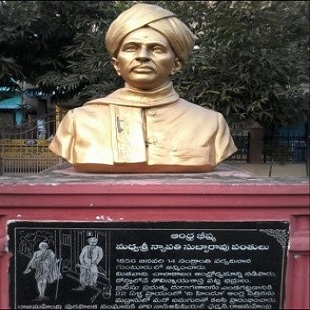
Nyapati Subbarao Panthulu, popularly known as Andhra Bhishma, was born on 14 January 1857 in a poor family in the Nellore district and later moved to Rajahmundry. He was a freedom fighter, journalist, and literary personality, and one of the founders of The Hindu. He not only achieved a high rank in matriculation but also received an award. After that, he joined Madras as a teacher and saved money for higher studies. While studying for a degree with a scholarship at a leading Christian College in Madras, he also completed his law degree. In 1880, he came to the Rajahmandry to practice as a lawyer. He has worked as a leader of the Bar Association for the shortest time and worked as a public prosecutor and government lawyer. He played a key role in the Indian National Congress from 1898 to 1917. In 1907, during the Vande Mataram movement, Bipin Chandra Pal was invited to Rajahmundry to give lectures there. He was a contemporary figure with a major public presence. He traveled to remote villages to inform the people of the need for independence in order to develop political knowledge among the people. After addressing the World Parliament of Religions in 1893 in Chicago, Swami Vivekananda returned to India by ship via Colombo on February 11, 1897. The ‘Triplicane Six’, who founded The Hindu in Madras in 1878, convened a meeting in Victoria Hall, Madras, to organise a welcome. The largely attended meeting elected Subbarao Pantulu as the Chairman of the Reception Committee. When the ship anchored at the Madras port, Subbarao was the first to garland Swami Vivekananda and receive him. Swami Vivekananda was given a grand reception in Victoria Hall on 12 February 1897. A public meeting was held on Marina Beach on February 14 where Swami Vivekananda and Subba Rao Pantulu shared the dais and the former spoke about the ‘Future of Bharat’. This was the beginning of a lasting friendship between the two. Inspired by Swami Vivekananda’s speeches he started the Hindu Samajam in Rajahmundry in 1903 for the propagation of the Bhagavad Gita and Sanatan Dharma. He also started the Historical Research Society. He was one of the founders of the Damerla Art Gallery. He introduced the Father of Harikatha Art, Adibhatla Narayana Dasu, to the Circar districts. In 1893 he revived the Chintamani magazine in Rajahmundry and made it available to the public. Kandukuri Veeresalingam was the editor of the magazine. Subbarao was instrumental in financially contributing to the essay on Chilakamarti Lakshminarasimha. In actively involved in public life as Rajhmandry city mayor, three times chairman of the municipality, and member of the district board. He represented the northern Telugu districts of the madras legislative council from 1893-1899. He presided over the madras presidency conference held at Visakhapatnam in 1907. Under the Minto-Morley Reforms, he become a member of the imperial legislative council in 1910 representing the non-official member of the madras legislative council. He was chairman of the reception committee for the madras session of the Congress in 1898 when Anand Mohan Bose presided. He was also General Secretary of the Indian National Congress from 1913 to 1927. He also established a night school at Rajahmundry for the benefit of the poor. He was a protagonist of a separate province for Andhra. He was rightly acclaimed as Andhra Bhishma - Grand Old Man of Andhra. He passed away on 5 January 1941 at the age of 84.